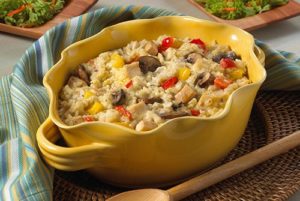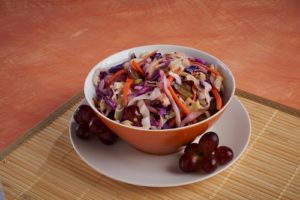Making Meal Prep Work for You
If you’re a fan of using food blogs or social media to find recipes, it’s likely you’ve come across the idea of meal prep.
What is Meal Prepping?
This popular concept is often shared by food and lifestyle bloggers on Pinterest, Instagram and other platforms as a strategy to save time and money. It is also a strategy to improve eating habits by cutting back on convenience foods that are often costly and less nutritious. On its surface, meal prep is simple: setting aside time to prepare food in advance. By doing this meals are ready-to-eat or much quicker-to-make when needed. However, a search of meal prep articles reveals many different methods.
Meal Prep Methods
Some common meal prep approaches include:
- Preparing ingredients – This method allows meals to be thrown together quickly. Examples include chopping vegetables and marinating meat for a quick stir-fry later that week.
- Refrigerated meals – Meals are fully prepared and then refrigerated. This works well for cold dishes, such as pasta salad, or items that require quick reheating. Meals may be stored in ready-to-eat portions or family style.
- Freezer meals – Meals are fully (or mostly) combined and ready to go from the freezer into the oven or a crockpot to reheat or cook. Occasionally, liquid ingredients like broth will be added at the time of cooking. This method is often used for casseroles and slow-cooked meals.
- Grab-and-go meals and snacks – This option focuses on having single meal or snack portions packaged portably. Think of lunch salads in containers that can be packed in a book bag, or mason jars of oatmeal to be reheated at the office. Healthy snacks may include whole grain and fruit muffins or sliced veggies ready for snack time.
- Combination – A variety of the above techniques may be used in a manner that fits an individual or family’s specific needs.
Customizing Your Meal Prep 
Making meal prep work for you can take some thoughtful meal planning.This is especially true if you have dietary restrictions for chronic kidney disease (CKD) or another health issue. Individuals with CKD might want to keep the following tips in mind when getting started:
- Know your specific diet guidelines. Diet recommendations vary based on stage of CKD and individual lab values. Work with your nephrologist or dietitian to understand whether you need more or less of certain nutrients, particularly protein, phosphorus, potassium and sodium. This will help you find recipes that work for you.
- Identify “pain points” when meal prep may be most useful. Take a moment to think through your daily and weekly routines. Dinners are a common time crunch, but some people may have more difficulty eating a nutritious breakfast or healthy snacks. Knowing where you struggle most will help you choose what foods to prep.
- Determine a meal prep time frame based on available prep time, storage space and frequency of grocery trips. Many advocates of meal prepping use a weekly schedule, where time is set aside over the weekend to plan and prepare for the week ahead. However, if you tend to have more free time on certain weekdays and are very busy on the weekend, you may choose to meal prep every Wednesday, for example. Likewise, some people prefer to schedule one larger block of time each month to meal prep. This might make sense if you only grocery shop monthly, but will require a larger amount of freezer space to safely store meals for longer periods.
Recipes
Look for kidney-friendly recipes that freeze and reheat well. Depending  on the meal prep strategy you’re using, you may need recipes that freeze well. Most casseroles can be assembled and frozen to cook later, or cooked and then refrigerated/frozen in several smaller portions to feed fewer people. Similarly, slow-cooker recipes can often be adapted for the freezer. This is commonly done by combining all non-liquid ingredients in a freezer safe bag or container. These contents will go directly into the crockpot along with the liquid ingredients on the day of cooking.
on the meal prep strategy you’re using, you may need recipes that freeze well. Most casseroles can be assembled and frozen to cook later, or cooked and then refrigerated/frozen in several smaller portions to feed fewer people. Similarly, slow-cooker recipes can often be adapted for the freezer. This is commonly done by combining all non-liquid ingredients in a freezer safe bag or container. These contents will go directly into the crockpot along with the liquid ingredients on the day of cooking.
 Select an easy to prepare salad such as Cabbage Salad (Ensalada de Repollo) to go with your meal. By cleaning and pre-cutting the produce you can put the salad together while cooking your meal.
Select an easy to prepare salad such as Cabbage Salad (Ensalada de Repollo) to go with your meal. By cleaning and pre-cutting the produce you can put the salad together while cooking your meal.
Stay safe! Meal prepping requires a lot of food handling, cooling, storage and reheating. Be sure to follow food safety guidelines to prevent foodborne illness.
If you decide to give meal prepping a try, DaVita.com is a great place for individuals with CKD to get started finding kidney-friendly recipes. We’d love to hear in the comments about your meal prep strategies and any DaVita recipes that you’ve used!
Additional Kidney Diet Resources
Visit DaVita.com and explore these diet and nutrition resources:
DaVita Kidney-Friendly Recipes
This article is for informational purposes only and is not a substitute for medical advice or treatment. Consult your physician and dietitian regarding your specific diagnosis, treatment, diet and health questions.

Recent Comments